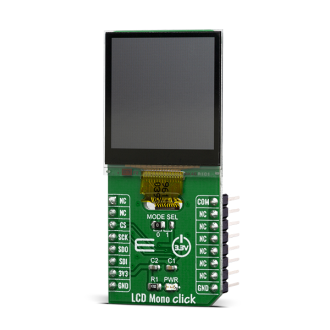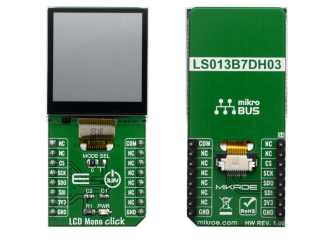
We strongly encourage users to use Package manager for sharing their code on Libstock website, because it boosts your efficiency and leaves the end user with no room for error. [more info]

Rating:
Author: MIKROE
Last Updated: 2019-10-23
Package Version: 1.0.0.0
mikroSDK Library: 1.0.0.0
Category: LCD
Downloaded: 4129 times
Not followed.
License: MIT license
LCD Mono Click is a Click boardâ„¢ that uses the LS013B7DH03 LCD display from Sharp which combined with the EFM32, from Silicon Labs, and its energy saving capabilities creates a powerful display application.
Do you want to subscribe in order to receive notifications regarding "LCD Mono click" changes.
Do you want to unsubscribe in order to stop receiving notifications regarding "LCD Mono click" changes.
Do you want to report abuse regarding "LCD Mono click".


Library Description
The library initializes and defines the SPI bus driver and drivers that offer a choice for writing data. The library includes function for displays image or frame, draw text on the screen and function for settings font.
Key functions:
void lcdmono_draw_const_frame ( const uint8_t *frame_data ) - Displays draw const framevoid lcdmono_draw_text ( char *text_buf, lcdmono_text_settings_t *cfg , uint8_t end_mode) - Draw text on the screenvoid lcdmono_set_font ( const uint8_t *font ) - Set fontvoid lcdmono_display_reset ( void ) - Reset procedureExamples description
The application is composed of three sections :
void applicationTask ( )
{
lcdmono_draw_const_frame( &demo_img_mikroe_light[ 0 ] );
Delay_ms( 3000 );
lcdmono_draw_const_frame( &demo_img_mikroe[ 0 ] );
Delay_ms( 3000 );
lcdmono_draw_const_frame( &demo_img_logo_light[ 0 ] );
Delay_ms( 3000 );
lcdmono_draw_const_frame( &demo_img_logo[ 0 ] );
Delay_ms( 3000 );
}
Create Image: Save the image in resolution of 128x128 px with the extension (monochrome bmp) ... Upload the image to Image2Lcd program Set parameters to:
The image to be generated should contain about 2048 bytes ... Insert the image into the file Click_LCD_Mono_image.h
Create Font: Close existing project, open a new VTFT project Add label and adjust text font Generate source code Copy the font from resource.c file to this project in file Click_LCD_Mono_font.h
Other mikroE Libraries used in the example:
Additional notes and informations
Depending on the development board you are using, you may need USB UART click, USB UART 2 click or RS232 click to connect to your PC, for development systems with no UART to USB interface available on the board. The terminal available in all MikroElektronika compilers, or any other terminal application of your choice, can be used to read the message.